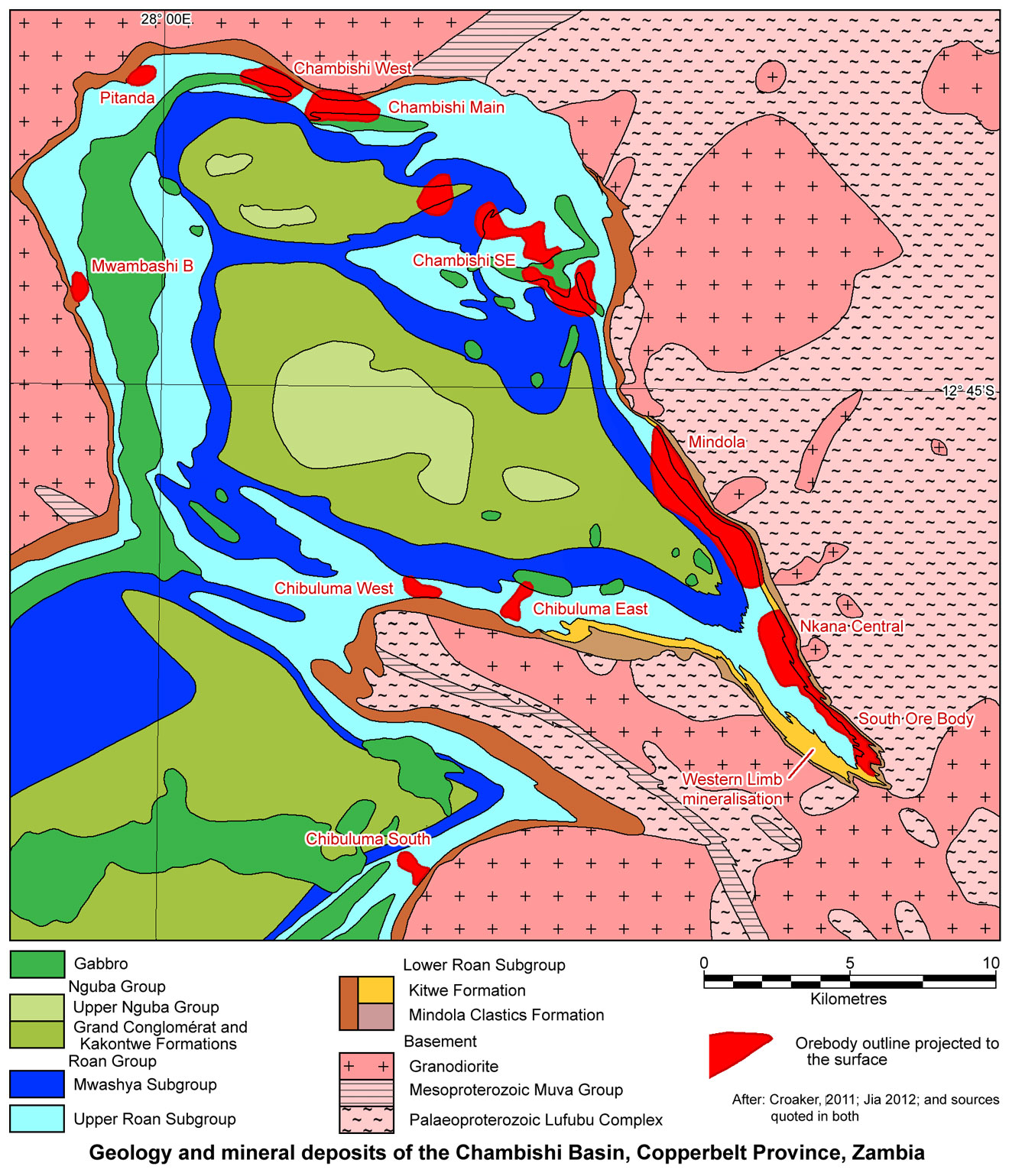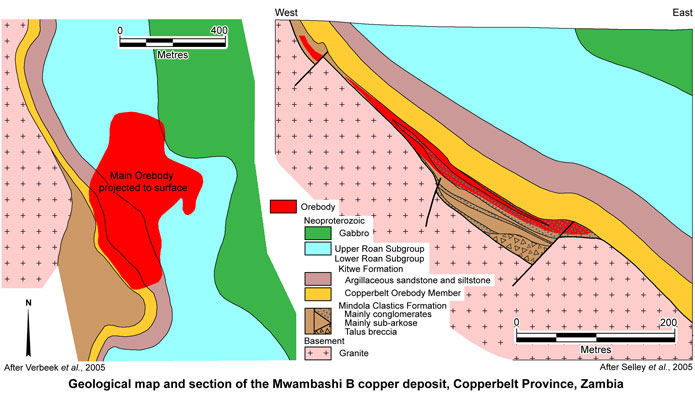|
Mwambashi B |
|
|
Zambia |
| Main commodities:
Cu Co
|
|
 |
|
 |
 |
Super Porphyry Cu and Au


|
IOCG Deposits - 70 papers

|
All papers now Open Access.
Available as Full Text for direct download or on request. |
|
 |
The Mwambashi B copper-cobalt deposit is located ~25 km SW of Chingola and ~35 km NW of Kitwe in northwestern Zambia (#Location: 12° 43"S, 28° 58"E).
The deposit is located on the western margin of the Chambishi structural basin, which is in turn, on the western limb of the regional Kafue Anticline. It was discovered in 1967, following early geological mapping in 1927, pitting in 1929, two drill holes in 1951, and a more concentrated exploration program of geophysical, geochemical, mapping and drilling from 1963 to 1967. Additional exploration and a feasibility study were untertaken between 1995 and 2006 (Freeman 1988; Jia et al., 2012 and sources cited therein).
Regional Setting
For details of the regional setting of the Mwambashi deposit, the Central African/Zambian Copper Belt and the Lufilian Arc, see the separate Zambian Copper Belt record.
Geology
The host Roan Group, of the Neoproterozoic Katanga Supergroup, overlies a Palaeoproterozoic basement complex, composed predominantly of granite, across an angular unconformity that dips at~35°NE. Mineralisation is hosted within the Lower Roan Subgroup, overlain by the Upper Roan and Mwashia Subgroups, and the Nguba Group. The Upper Roan Subgroup is frequently intruded by gabbros.
The deposit lies on the up-dip flank of a basement ridge which trends in a northwesterly direction, sub-parallel to the strike of the Lower Roan Subgroup sedimentary rocks. The host sequence, which comprises arenaceous sedimentary rocks, pinches out against basement along this ridge, both at depth, down-dip to the east, and to the north. These pinch-outs define the edges of the mineralised zones. The basement ridge, and variations in thickness within the Lower Roan Subgroup are influenced by a series of WNW to NW trending normal, pre-Kitwe Formation growth faults (Selley et al., 2005).
The host sequence rocks are correlated with the Mindola Clastics Formation, and are overlain by the "Ore Shale" of the basal Kitwe Formation, (the Copperbelt Orebody Member, or the OS1 member of the equivallent Nchanga Formation) which laps onto basement where the underlying arenites pinch out.
According to Selley et al. (2005), the Mindola Clastics Formation at Mwambashi B is as much as 160 m thick. A typical secion in the thickest part of the basin commences with ~80 m of conglomerate, with minor interbedded subarkose and argillaceous arenite, overlain by ~50 m of subarkose and argillaceous arenite with minor conglomerate interbeds. The remainder of the formation is ~60 m thick and is composed of a few to 10 m thick interbeds of the same conglomeratic and arkose/arenite lithologies which host the mineralisation. This sequence is very variable along strike and down dip. The Mindola Clastics Formation is overlain by the basal bed of the Kitwe Formation, 10 m of calcitic arenite, which is succeeded by 20 to 80 m of barren banded dolomitic shale of the Copperbelt Orebody Member.
These are overlain by the remainder of the Kitwe Formation, mainly argillaceous sandstone and siltstone, and then the Chingola carbonate member. The latter is variously included in the upper Kitwe Formation of the Lower Roan Subgroup, or lower Upper Roan Subgroup. The upper Chingola member is intruded by a thick, extensive amphibolite/gabbro sill, overlying the deposit to the east (Jia et al., 2012 and sources cited therein).
 Mineralisation
Mineralisation
The mineralisation at Mwambashi B has the same geological and mineralogical characteristics as the Chambishi deposit on the northern and northeastern sections of the Chambishi basin. The mineralisation is wedge-shaped, varying from 30 m thick in the shallower portions, to <1 m at depth, averaging 15 m. The main body is 600 m long and persists to ~250 m below the surface, where it is still open (Jia et al., 2012 and sources cited therein).
The mineralised arenites of the Mindola Clastics Formation are localised within fault-bounded/rift sub-basins to which the overlying barren shale has acted as an impermeable barrier to mineralised fluids. Selley et al. (2005) interpret the presence of strongly depleted δ13C values (-24‰) from carbonates of the Mwambashi B deposit, to be best explained by the former presence of migrated hydrocarbons trapped in the arenaceous sediments that host the orebody, after discussing the other possible options for these isotope values. These hydrocarbons are further interpreted to have acted as reductants, and were oxidised during precipitation of sulphide minerals from mineralised fluids to produce the carbonate gangue.
Most of the copper occurs as medium- to coarse-grained, stratabound, disseminated mineralisation in argillaceous quartzites and conglomerates of the Mindola Clastics Formation (Teal Exploration and Mining, 2005). A minor component of the primary mineralisation is hosted by veinlets that fill micro-fractures at the base of the deposit, indicating that at least some of the mineralisation post-dates lithification (Selley et al., 2005).
The upper portions of the deposit have undergone weathering with the result that copper sulphide minerals have been oxidized to form copper oxides, carbonates and silicates. A vertical mineral zonation occurs from entirely leached, through refractory, oxide, mixed supergene/oxide, supergene to sulphide mineralisation. Primary sulphide (chalcopyrite, bornite, carrollite) zones are often rimmed by 0.2 to 1 m wide intervals of secondary chalcocite at the upper and lower surfaces of the copper mineralised beds. Supergene enrichment processes are pronounced.
Below the overburden, the first 15 to 20 m of the mineralised body is predominantly oxidised, consisting mainly of malachite with subordinate chrysocolla and pseudomalachite. The underlying mixed sulphide-oxide zone has ratios of oxide:sulphide of 80:20 to 20:80 from top to bottom. The sulphide zone is predominantly composed of chalcopyrite, bornite and chalcocite.
The highest grades tend to be located at the base of the deposit, gradually decreasing upwards towards the shale capping of the basal Kitwe Formation.
The ore assemblage of the combined ore deposit is mainly composed of malachite, chalcocite, chalcopyrite, chrysocolla and pseudomalachite, with minor bornite and traces of cuprite and native copper.
Significant mineralisation is restricted to the northern part of the Mwambashi deposit, with an average grade of 0.4% Co, compared to the average for the deposit as a whole of 0.04%.
 Resource in 1988, distributed over a strike length of 800 m, extending ~400 m down dip to a depth of 50 to 300 m, with an average thickness of 8 m (Freeman, 1988), were: 5.7 Mt @ 2.81% Cu.
Resource in 1988, distributed over a strike length of 800 m, extending ~400 m down dip to a depth of 50 to 300 m, with an average thickness of 8 m (Freeman, 1988), were: 5.7 Mt @ 2.81% Cu.
Mineral resources at 31 December, 2010 (ARM Mineral Resources and Reserves Report, 2010), at a 0.5% Cu cutoff, were:
measured resource - 10.54 Mt @ 1.84% Cu Total;
indicated resource - 1.90 Mt @ 1.17% Cu Total;
Total measured + indicated resource - 12.44 Mt @ 1.74% Cu Total;
inferred resource - 1.77 Mt @ 2.10% Cu Total.
Resources at 31 December, 2011, were (Jia et al., 2012 and sources cited therein):
Oxidised ore
measured resource - 0.02 Mt @ 1.98% Cu Total, 1.69% Cu Acid Soluble
indicated resource - 0.14 Mt @ 1.44% Cu Total, 1.20% Cu Acid Sol.
inferred resource - 0.04 Mt @ 0.78% Cu Total, 0.66% Cu Acid Sol.
Mixed oxide and sulphide ore
measured resource - 0.54 Mt @ 2.26% Cu Total, 1.21% Cu Acid Sol.
indicated resource - 6.45 Mt @ 1.95% Cu Total, 0.89% Cu Acid Sol.
inferred resource - 0.36 Mt @ 1.72% Cu Total, 0.73% Cu Acid Sol.
Sulphide ore
measured resource - 0.26 Mt @ 2.15% Cu Total, 0.22% Cu Acid Sol.
indicated resource - 1.79 Mt @ 2.22% Cu Total, 0.23% Cu Acid Sol.
inferred resource - 1.37 Mt @ 2.24% Cu Total, 0.13% Cu Acid Sol.
TOTAL
measured resource - 0.82 Mt @ 2.22% Cu Total, 0.91% Cu Acid Sol.
indicated resource - 8.38 Mt @ 2.00% Cu Total, 0.75% Cu Acid Sol.
inferred resource - 1.77 Mt @ 2.10% Cu Total, 0.26% Cu Acid Sol.
This summary is largely derived from the reference(s) listed below and Jia, Y., (Compiler), 2012 - Technical assessment report on CNMC's copper properties in Copperbelt Province, Republic of Zambia, prepared for China Non-ferrous Metals Mining (Group), Co., Ltd. by SRK Consulting (China) Ltd.
The most recent source geological information used to prepare this decription was dated: 2012.
This description is a summary from published sources, the chief of which are listed below.
© Copyright Porter GeoConsultancy Pty Ltd. Unauthorised copying, reproduction, storage or dissemination prohibited.
|
|
|
|
|
Selley D, Broughton D, Scott R, Hitzman M, Bull S, Large R, McGoldrick P, Croaker M and Pollington N, 2005 - A new look at the geology of the Zambian Copperbelt: in Economic Geology, 100 Anniversary Volume, Society of Economic Geologists, pp. 965-1000
|
|
Porter GeoConsultancy Pty Ltd (PorterGeo) provides access to this database at no charge. It is largely based on scientific papers and reports in the public domain, and was current when the sources consulted were published. While PorterGeo endeavour to ensure the information was accurate at the time of compilation and subsequent updating, PorterGeo, its employees and servants: i). do not warrant, or make any representation regarding the use, or results of the use of the information contained herein as to its correctness, accuracy, currency, or otherwise; and ii). expressly disclaim all liability or responsibility to any person using the information or conclusions contained herein.
|
Top | Search Again | PGC Home | Terms & Conditions
|
|